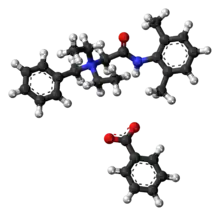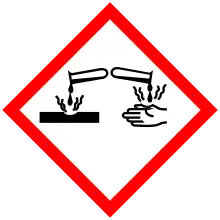Denatonium
 | |
 | |
 | |
| Names | |
|---|---|
| Preferred IUPAC name
N-Benzyl-2-(2,6-dimethylanilino)-N,N-diethyl-2-oxoethan-1-aminium benzoate | |
| Other names
N-Benzyl-2-[(2,6-dimethylphenyl)amino]-N,N-diethyl-2-oxoethan-1-aminium benzoate | |
| Identifiers | |
CAS Number |
|
3D model (JSmol) |
|
| ChEMBL | |
| ChemSpider | |
| ECHA InfoCard | 100.020.996 |
| EC Number |
|
PubChem CID |
|
| UNII | |
CompTox Dashboard (EPA) |
|
InChI
| |
SMILES
| |
| Properties | |
Chemical formula |
C28H34N2O3 |
| Molar mass | 446.581 |
| Appearance | white crystalline |
| Melting point | 163 to 170 °C (325 to 338 °F; 436 to 443 K) |
| Hazards | |
| GHS labelling: | |
Pictograms |
  |
Signal word |
Danger |
Hazard statements |
H302, H315, H318, H332, H412 |
Precautionary statements |
P261, P264, P270, P271, P273, P280, P301+P312, P302+P352, P304+P312, P304+P340, P305+P351+P338, P310, P312, P321, P330, P332+P313, P362, P501 |
| NFPA 704 (fire diamond) | |
Except where otherwise noted, data are given for materials in their standard state (at 25 °C [77 °F], 100 kPa). | |
| Infobox references | |
Denatonium, usually available as denatonium benzoate (under trade names such as Denatrol, BITTERANT-b, BITTER+PLUS, Bitrex, and Aversion) and as denatonium saccharide (BITTERANT-s), is the most bitter chemical compound known, with bitterness thresholds of 0.05 ppm for the benzoate and 0.01 ppm for the saccharide.[1] It was discovered in 1958 during research on local anesthetics by MacFarlan Smith of Edinburgh, Scotland, and registered under the trademark Bitrex.[2]
Dilutions of as little as 10 ppm are unbearably bitter to most humans. Denatonium salts are usually colorless and odorless solids but are often traded as solutions. They are used as aversive agents (bitterants) to prevent inappropriate ingestion. Denatonium is used in denatured alcohol,[3] antifreeze, preventive nail biting preparations, respirator mask fit-testing, animal repellents, liquid soaps, shampoos, and Nintendo Switch game cards to prevent accidental swallowing or choking by children. It is not known to pose any long-term health risks.[1]
The name denatonium reflects the substance's primary use as a denaturant and its chemical nature as a cation, hence the New Latin suffix -onium.
Structure and physical properties
Denatonium is a quaternary ammonium cation. It is a compound of a salt with an inert anion like benzoate or saccharide. The structure of denatonium is related to the local anesthetic lidocaine, differing only by the addition of a benzyl group to the amino nitrogen. Other similar compounds are procaine and benzocaine.[4]
One of the chemical names for the compound is lidocaine benzylbenzoate, although denatonium only denotes the quaternary ammonium cation species itself, and does not necessitate the benzoate counterion.
Biochemistry
Denatonium in humans is recognized by eight distinct bitter taste receptors: TAS2R4, TAS2R8, TAS2R10, TAS2R39, TAS2R43, TAS2R16, TAS2R46, TAS2R47, with TAS2R47 being by far the most sensitive to the compound.[5][6]
Denatonium can act as a bronchodilator by activating bitter taste receptors in the airway smooth muscle.[7]
Applications
The bitterness of the compound guides most applications of denatonium. Denatonium benzoate is used to denature ethanol so that it is not treated as an alcoholic beverage with respect to taxation and sales restrictions. One designation in particular, SD-40B, indicates that ethanol has been denatured using denatonium benzoate.
Denatonium is commonly included in placebos used in clinical trials to mimic the bitter taste of certain medications.[1]
Denatonium also discourages consumption of poisonous alcohols such as methanol and additives such as ethylene glycol. It is also added to many kinds of harmful liquids including solvents (such as nail polish remover), paints, varnishes, toiletries and other personal care items, special nail polish for preventing nail biting, and various other household products. It is also added to less hazardous aerosol products (such as gas dusters) to discourage inhalant abuse of the volatile vapors.
In 1995, the U.S. state of Oregon required that denatonium benzoate be added to products containing sweet-tasting ethylene glycol and methanol such as antifreeze and windshield washer fluid to prevent poisonings of children and animals.[8] In December 2012, U.S. manufacturers voluntarily agreed to add denatonium benzoate to antifreeze sold nationwide.[9]
Animals are known to have different sensitivities to the effects of denatonium. It is used in some animal repellents (especially for such large mammals as deer). It has been used to safeguard rat poisons from human consumption,[10] as humans are able to detect denatonium at much lower concentrations than rodents.[11]
Nintendo Switch game cards are coated in denatonium benzoate to prevent young children from consuming them.[12]
See also
- Amarogentin
References
- 1 2 3 Final Report Study of Aversive Agents (PDF). Consumer Product Safety Commission United States of America. 18 November 1992. Archived from the original (PDF) on 16 June 2011. Retrieved 15 November 2010.
- ↑ "Bitrex(R) — Branded Denatonium Benzoate". Macfarlan Smith. Retrieved 2010-05-09.
- ↑ "Ethanol Denaturants". The Online Distillery Network. 1993-11-22. Archived from the original on 2015-05-10. Retrieved 2007-09-30.
- ↑ Holvoet, Jean-Patrick. "Denatonium". Sentinalco. Retrieved 2 October 2015.
- ↑ Meyerhof, W.; Batram, C.; Kuhn, C.; Brockhoff, A.; Chudoba, E.; Bufe, B.; Appendino, G.; Behrens, M. (2009). "The Molecular Receptive Ranges of Human TAS2R Bitter Taste Receptors". Chemical Senses. 35 (2): 157–170. doi:10.1093/chemse/bjp092. PMID 20022913.
- ↑ "BitterDB - Denatonium benzoate". Hebrew University of Jerusalem. Retrieved 11 June 2013.
- ↑ Deshpande, D. A.; Wang, W. C. H.; McIlmoyle, E. L.; Robinett, K. S.; Schillinger, R. M.; An, S. S.; Sham, J. S. K.; Liggett, S. B. (2010). "Bitter taste receptors on airway smooth muscle bronchodilate by localized calcium signaling and reverse obstruction". Nature Medicine. 16 (11): 1299–1304. doi:10.1038/nm.2237. PMC 3066567. PMID 20972434.
- ↑ Mullins ME, Zane Horowitz B (June 2004). "Was it necessary to add Bitrex (denatonium benzoate) to automotive products?". Veterinary and human toxicology. 46 (3): 150–2. ISSN 0145-6296. PMID 15171494.
- ↑ "Antifreeze and Engine Coolant Being Bittered Nationwide". Consumer Specialty Products Association. 13 December 2012. Archived from the original on 28 December 2012. Retrieved 30 June 2016.
- ↑ "Rats - Rat Poison & Rat Bait Stations". Pestcontrolshop.co.uk. Archived from the original on 2011-01-06. Retrieved 2011-01-17.
- ↑ Frank ME, Bouverat BP, MacKinnon BI, Hettinger TP. The distinctiveness of ionic and nonionic bitter stimuli. Physiol Behav. 2004 Jan;80(4):421-31. doi:10.1016/j.physbeh.2003.09.009
- ↑ Dornbush, Johnathon (2 March 2017). "Nintendo Switch Cartridges Taste Terrible". IGN. Retrieved 15 Sep 2020.
